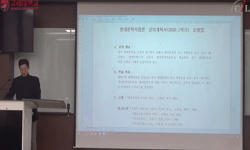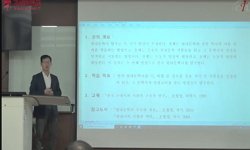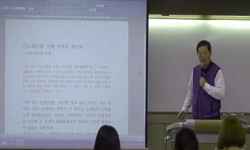한국시에 나타난 불교생태의식 연구 오늘날 인간과 자연의 총체적 위기 앞에서 인류는 단순히 자연환경의 보호 차원이 아니라 정신적 패러다임의 전환을 강력히 요구받고 있다. 이것은 ...
http://chineseinput.net/에서 pinyin(병음)방식으로 중국어를 변환할 수 있습니다.
변환된 중국어를 복사하여 사용하시면 됩니다.
- 中文 을 입력하시려면 zhongwen을 입력하시고 space를누르시면됩니다.
- 北京 을 입력하시려면 beijing을 입력하시고 space를 누르시면 됩니다.
https://www.riss.kr/link?id=T12468724
- 저자
-
발행사항
서울: 숭실대학교 대학원, 2011
-
학위논문사항
학위논문(박사)-- 숭실대학교 대학원: 국어국문학과 2011. 8
-
발행연도
2011
-
작성언어
한국어
- 주제어
-
DDC
811.1509 판사항(21)
-
발행국(도시)
서울
-
기타서명
A Study on the Buddhist Ecological Consciousness in Korean Poetry
-
형태사항
xiii, 207p: 삽도; 26cm.
-
일반주기명
숭실대학교 논문은 저작권에 의해 보호받습니다.
지도교수:한승옥
참고문헌: p. - 소장기관
-
0
상세조회 -
0
다운로드
부가정보
국문 초록 (Abstract)
한국시에 나타난 불교생태의식 연구
오늘날 인간과 자연의 총체적 위기 앞에서 인류는 단순히 자연환경의 보호 차원이 아니라 정신적 패러다임의 전환을 강력히 요구받고 있다. 이것은 인식과 실제생활을 포괄하는 총체적 관념을 새로운 세계관으로 수용하여 변화되어야 한다는 것을 의미한다. 다시 말해서 인간과 만물을 하나로 싸안는 진정한 통섭[conciliation]의 사유를 바탕으로 조화와 상생의 관계를 회복해야 한다는 것이다.
서구의 생태ㆍ환경론자들은 1960년대 이후 새로운 세계관을 모색하기 위하여 생태학과 불교의 결합을 모색하기 시작했다. ‘모든 존재들이 상호연관성을 갖는다’는 생각은 생태학과 불교가 공유하는 사상의 핵심적 전제다. 불교사상이 생태철학으로서 가장 적합하다고 판단한 생태학자들과 불교학자들은 1980년대 후반부터 생태위기의 문제들을 불교사상에 근거하여 극복하고자 진지한 탐구를 시작하였다. 불교와 생태학의 본질이나 지향성이 매우 유사하다는 인식에서 출발한 ‘불교생태학’은 이론과 실천적인 측면에서 생태학의 큰 줄기를 형성하며 간학문적(間學問的) 통합 효과를 발휘하고 있다. ‘연기→상호의존성’의 통찰을 통해 ‘무자성→비실체성ㆍ공성’의 인식으로 이어져 나눔의 ‘자비행→상호존중성’으로 귀결되는 불교생태학은 자연과 우주의 포용을 그 핵심으로 한다.
한국시를 불교생태학적 관점에서 분석하고자 한 이 논문은 생태문제에 관한 문학적 대안, 불교생태시학의 시사적 위상과 의의 등에 관한 입체적 담론이다. 문학의 기능이나 효용이 교훈과 쾌락에 있다고 한다면, 불교생태시는 여느 장르들보다 가장 절묘하게 교훈과 쾌락이 조화를 이루는 통합적 구조체다. 이런 점에서 불교생태학적 상상력이 상당 기간 구현되어 온 개별 시작품들을 통시적 관점에서 분석ㆍ연구하는 일이야말로 매우 시의적절한 일이라 할 수 있다.
불교생태시학의 관점에서 한국문학사는 세 단계로 구분된다. 고려의 이규보와 조선의 김시습이 대표하는 한국전통생태학과 불교생태의식의 萌芽 단계, 한용운과 조지훈이 대표하는 불교생태의식의 패러다임의 전환과 정착 단계, 오늘날의 김지하와 최승호가 대표하는 불교생태의식의 다각화와 심화단계 등이 그것들이다. 약 800년이라는 시간적 흐름 위에 놓여있는 이상의 여섯 시인들은 외견상 상호 공통성이나 유사성이 없는 것처럼 보일 수 있다. 그러나 이들로부터 발견하게 되는 것은 본격적으로 생태문제가 대두되기 훨씬 이전부터 우리 사회에 생태학적 사유가 면면히 맥을 이어왔다는 사실이다. 이들의 작품이 공유하고 있는 정신은 불교사상을 바탕으로 한 ‘상생적 생태관’이다. 이들은 불교사상과 생태학적 상상력을 미학적으로 수용ㆍ발전시켜 불교생태시학의 정신사적 기반을 탄탄하게 다져왔다. 이들은 시대를 초월하여, 불교사상과 생태학적 상상력을 시적 자양분으로 삼아 유기체적 언어와 이미지들을 창조해 왔던 것이다.
이규보는 인간 본위의 관점에서가 아니라 萬物一類의 관점에서 물마다 내재해 있는 생명력에 대한 외경으로 그의 시편들을 형상화했다. 그는 사물을 단순한 도구나 이용 대상으로 여기지 않고 인간과 내면적으로 연결되어 있는 존재라는 사고 아래 만물일류의식과 연기의 시학을 펼쳤다. 그가 보여 준 餘物意識, 생명에 대한 존중의 정신, 虛心 등을 발전시킨 만물일류사상은 붓다의 緣起論이나 慈悲心과 상통한다.
자연의 순환적 이법에 따라 인간과 만물이 존재하고 변해간다는 생각으로부터 김시습의 愛物意識과 無我의 시학은 출발되었다. 사물에 대한 상호존중의 자비심과 생태윤리의 실천, 농민의 노동 가치에 대한 높은 평가, 방외인적 삶을 통한 무명의 깨달음 등이 김시습이 자신의 시에서 구현한 불교생태학적 사고의 핵심이다.
사랑, 자유, 평등, 생명 등은 한용운의 시편에 관류하는 불교사상으로부터 발원된 사유들이다. 화자와 시적 대상인 님 사이에 ‘기룸’의 행위를 개입시킴으로써 인간의 자아 개념을 자연으로 무궁히 확대하여 인간과 우주의 합일을 상정한다. 여기에 한용운의 불교생태학적 세계관의 핵심이 자리한다. 그의 ‘기룸’은 자비의 심미적 관조를 미화함으로써 만물평등주의를 형상화한 것이다. 이것은 자연과 우주가 인간의 타자적 개념이 아니라, 곧 ‘나’와 다를 바 없다는 인식에서 출발한 보살적 자비심의 實踐躬行이다. 자연과 인간을 萬物同根의 연기론으로 파악하여 생물과 무생물을 존중하는 마음에서 출발한 것이 조지훈이 이룩한 생명과 無自性의 시학이다. 그의 작품에서 모든 생물이나 무생물이 사실은 나와 다름없는 ‘일체’이기에 무자성을 강조했으며, 인간중심주의에 대한 거부가 표출되기도 했다.
김지하의 생명시학은 ‘애린’과 ‘모심[侍]’이다. ‘엇’에서 ‘흰 그늘’이 형성되었고, 그것이 다시 ‘애린’이라는 다중적인 얼굴로 실체화되었다. 그런 전환들을 통해 인간의 욕망에 의해 변질된 비생명적 세계를 비판ㆍ고발하고 생명세계를 옹호한 것이다. ‘모심’의 윤리는 그런 시적 여정의 끝
다국어 초록 (Multilingual Abstract)
ABSTRACT A Study on the Buddhist Ecological Consciousness in Korean Poetry In the face of structural crisis threatening human existence as well as the nature, men are asked to go through fundamental paradigm shift just beyond the simple gest...
ABSTRACT
A Study on the Buddhist Ecological Consciousness in Korean Poetry
In the face of structural crisis threatening human existence as well as the nature, men are asked to go through fundamental paradigm shift just beyond the simple gesture to protect nature. This implies that holistic conception influencing perception as well as everyday life should be embraced to bring about fundamental change in human life. In other words, harmonious and coexistent relationship should take root in every walk of life based on conciliation equally treating human beings and other living things in genuine sense.
Since the 1960s, ecological environmentalists in Western world have looked for ways to connect ecology with Buddhism. The thought that ‘every existence in the world is interconnected’ commonly constitutes a core part of ecology and Buddhism. Since the late 1980s, the Buddhist ecologists, on realization that Buddhism may be the solution to the ecological crisis, have devoted themselves to developing ways of applying Buddhism. That is where “Buddhist ecology” comes. “Buddhist ecology” has become a big part of ecology in terms of theory and practice on a premise that both Buddhism and ecology intrinsically share the same nature and destination, prompting holistic approach to ecology. Specifically, the Buddhist ecology provides insight into “the chain of dependent origination → interdependence” and “no self-nature → no substance, emptiness” to emphasize importance of “compassion → mutual respect”, inducing one to embrace both the nature and the universe as they are.
The study focuses on analyzing Korean poems from the perspective of Buddhist ecology and thereby presents multi-faceted viewpoints regarding status of Korean literature in the context of ecology and current status and implication of Buddhist ecology. If it is true that important function and effectiveness of literature lie in giving lessons and increasing pleasure, it will surely be true that Buddhist ecological poem represents holistic entity embodying unrivaled harmony of lessons and pleasure. In this respect, now is the ripe time to study and analyze poems representing Buddhist ecological imagination from the holistic perspective.
From the viewpoint of Buddhist ecological poetic theory, Korean literature may be divided into three phases: encounter of traditional ecological perception represented by Lee, Kyu-bo during the Korea Dynasty and Kim, Si-seup during the Chosun Dynasty; modernism represented by Han, Yong-woon and Cho, Ji-hoon; and diversification and development of Buddhist ecological conception represented by Kim, Ji-ha and Choi, Seung-ho. Apparently the six poets mentioned above have nothing in common with one another due to long intervals spanning about 800 years. Certainly, however, their presence suggests that ecological thought has weaved itself into our history of literature well before ecological issues came to surface. And their literatures commonly advocate “coexistent ecological ideas” based on Buddhism. By aesthetically embracing Buddhism and ecological imagination, they philosophically laid foundation for development of Buddhist ecological poetic theory. The poets transcended immediate needs of the time to organically create language and poetic images by tapping into Buddhism and ecological imagination.
Lee Kyu-bo brought life to his poems out of respect for life present in everything rather than from human-centered viewpoint. Instead of regarding things as simple tool or something useful, he believed that things are intrinsically interconnected with human beings, which led him to present his philosophy regarding causation of dependent origination and equal treatment of everything in the world. His emphasis on equal treatment of everything which led to deep respect for life and compassion is consistent with Buddha’s causation of dependent origination and compassion.
Meanwhile, Kim Si-seup developed poetic theory regarding love for everything and “no-self” nature on the thought that human beings and the nature change in accordance with cyclic law of nature. Mutual respect for things and ecological ethics, valuing farmers’ labor and realization of meaningless life on the path of outsider’s life constitutes a core part of the poet’s Buddhist ecological idea pervading his poems.
The themes like love, freedom, equality and life, permeating Han Yong-woon’s poems, all stem from Buddhist thought. In his poem, the poet places “Girum” between narrator and poetic object “You.” In doing so, the poet indefinitely expands the concept of “self” to the nature and pursues holistic integration of the nature and human beings. That is where Han Yong-woon’s Buddhist ecological conception importantly comes to surface. His “Girum” is an embodiment of equalitarianism by introducing aesthetic reflection on compassion. This implies that the nature and the universe are not disparate but constitute “I,” leading one to act compassionately.
In his “no-self” poetic theory, Jo Ji-hoon says that nature and human beings have the same origin, raising the need to equally treat animate and inanimate things. In his poems, he emphasizes that both animate and inanimate things are not disparate from “I” expressing repulsiveness against human centrism.
Kim Ji-ha’s poetic philosophy may be summarized as “Aelin” and “Mosim[侍]”. In his poem, white shadow arises from ‘Eot (Alternative Mix)’. It again is materialized into Aelin or multi-faced reality, debunking callous reality of the world distorted and contaminated by human desire and advocating world filled with living things. His poetic journey finally ends with “Mosim,” an ethical code essentially pursued by the poet in his poetic journey. “Mosim” may be expressed as mutual respect or compassion that Buddhist ecology considers essential value. Deep respect for every
목차 (Table of Contents)
- 목 차
- 國文抄錄 ⅴ
- 英文抄錄 ⅸ
- 목 차
- 國文抄錄 ⅴ
- 英文抄錄 ⅸ
- 제 1 장 서론 1
- 1.1 연구 목적과 범위 1
- 1.2 연구방법과 대상 7
- 1.3 연구사 검토 12
- 제 2 장 불교생태학과 불교생태문학 24
- 2.1 생태학과 불교 24
- 2.2 불교생태학 29
- 2.2.1 연기와 자비의 생태사상 32
- 2.2.2 不殺生의 생명윤리관 37
- 2.3 불교생태문학과 불교생태시 40
- 제 3 장 한국전통생태학과 불교생태의식의 萌芽 44
- 3.1 이규보의 萬物一類의식과 緣起의 시학 44
- 3.1.1 無明의 극복과 空의 깨달음 46
- 3.1.2 緣起에 바탕을 둔 상생의 세계관 51
- 3.1.3 생명평등사상과 자비의 실천 57
- 3.2 김시습의 愛物과 無我의 시학 64
- 3.2.1 愛物과 자비의 실천 65
- 3.2.2 愛民과 생태사회적 윤리관 74
- 3.2.3 방외적인 삶을 통한 무명의 자각 80
- 제 4 장 불교생태의식의 패러다임의 전환과 정착 86
- 4.1 한용운의 ‘기룸’과 상생의 시학 86
- 4.1.1 ‘기룸’과 자비의 서정 91
- 4.1.2 不二의 사유와 자아의 확대 98
- 4.1.3 만물평등의 상생관 105
- 4.2 조지훈의 생명과 無自性의 시학 111
- 4.2.1 相卽相入의 緣起論的 세계관 111
- 4.2.2 無子性과 無明에 대한 깨달음 118
- 4.2.3 생명의 全一性과 실천적 생태윤리 125
- 제 5 장 불교생태의식의 다각화와 심화 132
- 5.1 김지하의 ‘애린’과 ‘모심[侍]’의 시학 132
- 5.1.1 ‘흰 그늘’의 이미지와 대립의 지양 135
- 5.1.2 생명의식의 깨달음과 ‘애린’ 145
- 5.1.3 상호존중과 실천윤리로서의 ‘모심’ 154
- 5.2 최승호의 순환과 空의 시학 160
- 5.2.1 三毒心과 無明의 극복을 통한 생태학적 자각 163
- 5.2.2 물의 순환과 空을 통한 상생의 세계관 168
- 5.2.3 안-밖의 통합과 華嚴세계의 구현 175
- 제 6 장 불교생태시의 전통성과 시사적 의의 181
- 제 7 장 결론 186
- 참고문헌 193












